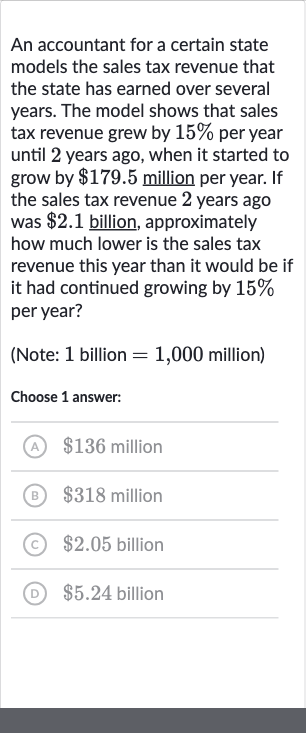AI tutor
Welcome to Bytelearn!
Let’s check out your problem:

An accountant for a certain state models the sales tax revenue that the state has earned over several years. The model shows that sales tax revenue grew by per year until years ago, when it started to grow by million per year. If the sales tax revenue years ago was billion, approximately how much lower is the sales tax revenue this year than it would be if it had continued growing by per year?(Note: billion million)Choose answer:(A) million(B) million(C) billion(D) billion
Full solution
Q. An accountant for a certain state models the sales tax revenue that the state has earned over several years. The model shows that sales tax revenue grew by per year until years ago, when it started to grow by million per year. If the sales tax revenue years ago was billion, approximately how much lower is the sales tax revenue this year than it would be if it had continued growing by per year?(Note: billion million)Choose answer:(A) million(B) million(C) billion(D) billion
- Calculate % Growth: To find out the sales tax revenue if it had continued to grow by % per year, we need to calculate the revenue for the past two years with a % increase each year. Starting with billion, we first calculate the revenue for the first year after the change.
- Calculate st Year: Perform the calculation for the first year's revenue with a % increase. Revenue after year at % growth = billion Revenue after year at % growth = billion Revenue after year at % growth = billion
- Calculate nd Year: Now, calculate the revenue for the second year with another % increase on the first year's revenue.Revenue after years at % growth = billion Revenue after years at % growth = billion Revenue after years at % growth = billion
- Calculate Actual Revenue: Next, we calculate the actual revenue for the past two years with a flat increase of million per year. Starting again with billion, we add million for each of the two years.Actual revenue after year = billion + millionActual revenue after years = ( billion + million) + million
- Convert to Billion: million billion Now perform the calculation for the actual revenue after two years.Actual revenue after year = billion + billionActual revenue after year = billionActual revenue after years = billion + billionActual revenue after years = billion
- Calculate the Difference: Now, we find the difference between the projected revenue if it had grown by % per year and the actual revenue with the flat increase.Difference = Projected revenue after years at % growth - Actual revenue after yearsDifference = billion - billion
- Round to Nearest Million: Perform the calculation for the difference.Difference = billion - billionDifference = billionDifference = million Since we need to approximate the difference and the options are given in whole millions, we round the difference to the nearest million.Approximate difference = million
More problems from Find probabilities using combinations and permutations
QuestionGet tutor help
QuestionGet tutor help
QuestionGet tutor help
QuestionGet tutor help
QuestionGet tutor help
QuestionGet tutor help
QuestionGet tutor help
QuestionGet tutor help
QuestionGet tutor help
